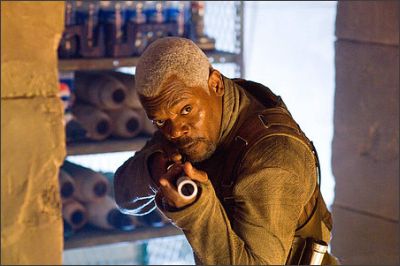
Taking off from what Gould, Goyer and a second screenwriter, Jim Uhls, had started, Liman, Kinberg and Foster began forging a vast, eons-long history for the Jumpers, whose ability to bend time and space with their minds is passed down in a family lineage than can be traced back in time for thousands of years.
The team began by researching the pantheon of beliefs about teleportation, from the mystical to the cutting-edge physics theories that could make it possible. "We talked to a lot physicists so we could understand the science of how teleportation might work and we used that to ground the story in reality. But we also researched the mythology of teleporting, which has been part of the cultural imagination for thousands of years," explains Kinberg. "Sufi and Hindu mystics supposedly practiced teleportation centuries ago. I think the idea of being able to put yourself instantly on a mountain that no one can climb, or just the ability to do mundane, everyday things in life such as being able to skip over the line in the passport office, offers huge appeal to the imagination. The wish fulfillment element is really strong."
But the wide-open nature of Jumping also offers equal opportunities for evil-doers. "Instead of using jumping to do cool, fun things like eating breakfast on top of the Sphinx then going surfing in Australia in the blink of an eye, someone with bad intentions could take a nuclear weapon and drop it in the White House, or do other evil things. When you think it through, you realize that while Jumping is amazing, it can also be a kind of curse," notes Foster. "If the power is in the wrong hands, or used by someone to manipulate Jumpers, they could be anywhere and do anything."
This stark reality in turn led to the concept of the Paladins, a highly secretive, elite force that for several thousand years has tried to stop Jumpers from using their dangerous powers for ill gain. Those Jumpers who make it to adulthood become the instantaneous targets of the merciless Paladin agency, who will do anything to eliminate them, no questions asked, no matter what.
To set a solid foundation for the epic story's complex inner mechanics, the team came up with two foundational rules of Jumping:
1) You can jump anywhere that you can currently see; and
2) You can jump anywhere that you've seen before, even in a photograph, so long as you have a strong visual memory of it.
Also integral to the rules of Jumping are the "Jump Scars," momentary blips or rends in the space-time fabric left behind by a Jumper -- and which any other Jumper can use to follow their trail.
Then there are "tethers," electronic weapons which the Paladins use to ground, trace and ultimately eliminate free-roaming Jumpers. A tether is a Jumper's worst nightmare.
Despite the fantastical nature of all these elements of teleportation, the emphasis always remained on keeping things as rooted in the real world as possible. "We wanted this story to feel like it could truly take in our world in our time," notes Kinberg. "David Rice doesn't wear a cape, he doesn't have a code ring. In most ways he's an ordinary guy with a single incredible, abnormal ability -- and how he deals with that is really the core of our movie. How would any of us react if we suddenly discovered we'd inherited an ability that could make our lives very exciting and free? David has a very human impulse to use his teleportation to better his own life. It's only in the course of the story that he learns that he can do much more than just rob banks and live in penthouses. He begins to see that he can help his loved ones and even strangers."
Equally vital to the story is how a Jumper like David Rice might handle falling in love. Continues Kinberg: "The Jumping allowed us to explore a theme that's central to every good love story -- which is whether you can ever really be in a good relationship with someone unless you're fully honest with them. It's something we also explored in Mr. And Mrs. Smith in a very different way."
By now, the producers were also getting very keyed up about having Doug Liman at the helm of this truly unique vehicle. His spontaneous, creative, on-the-fly, guerrilla style of filmmaking seemed a perfect fit for a story about unbridled mobility. "What's going to be really exciting about this story is not just the ideas behind it but the tone, the look, the grittiness, the rawness and the real emotion," sums up Kinberg. "It's not something you've seen before in the superhero world. It's not the bright and shiny universe of Spider-Man. It's not the dark and gothic netherworld of Batman. Doug's strong sense of realism brings some very fresh blood to the superhero genre, and twists and tweaks it in playful ways."
Adds Foster: "Doug pumped new life into the espionage theme with The Bourne Identity, raised the bar on action/comedy with Mr. and Mrs. Smith and now does the same now for Jumping."
No comments:
Post a Comment